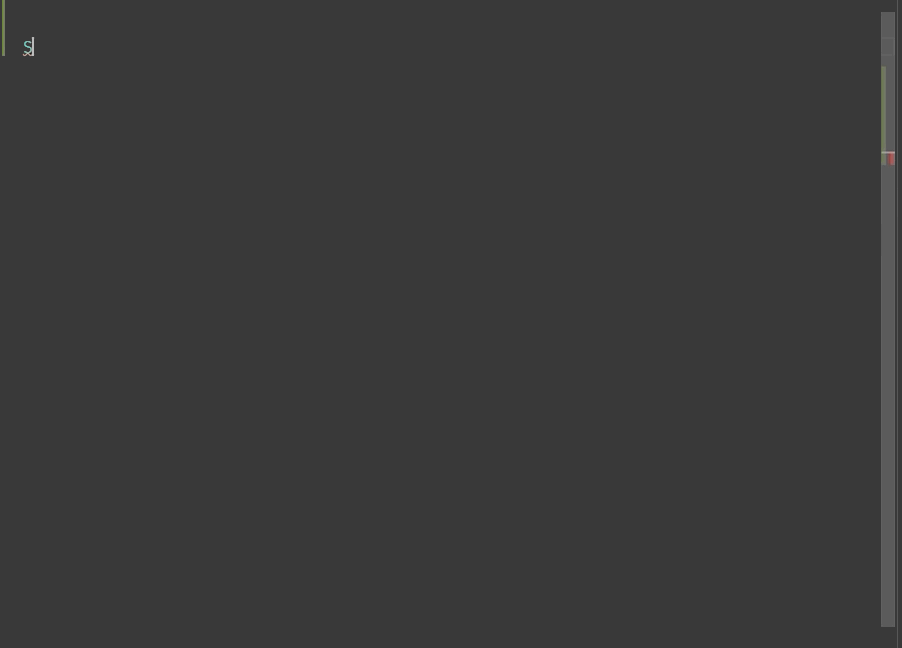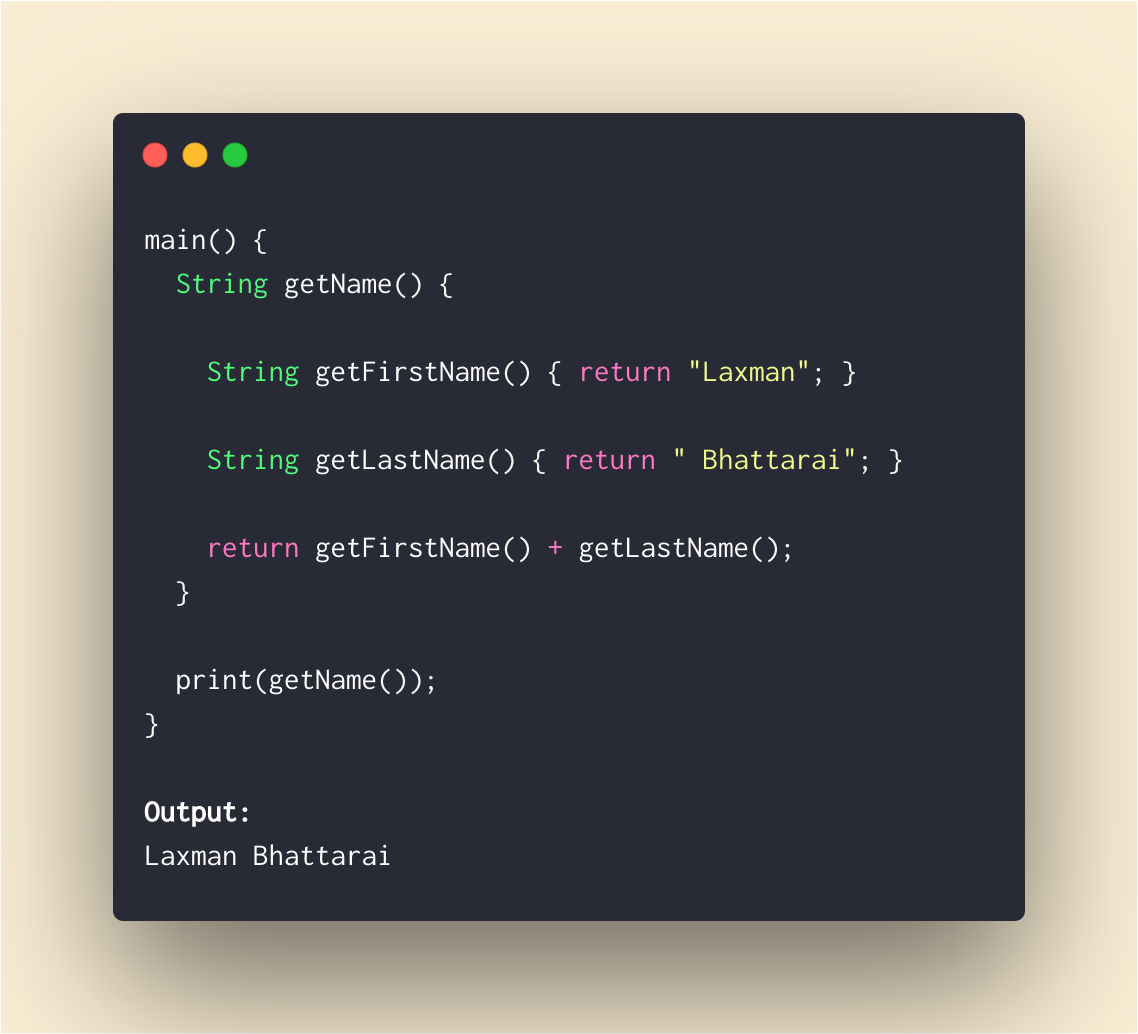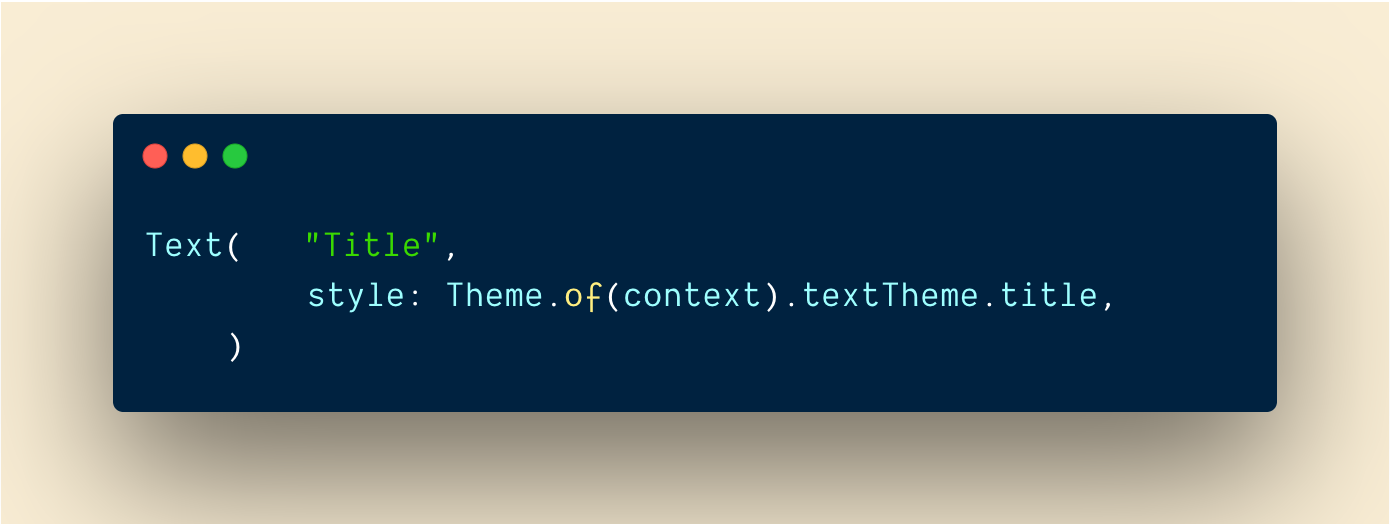We can type stless and stful and we get Autocomplete Suggestion to generate Stateless Flutter Widget or Stateful Flutter Widget Respectively.
?? checks If something is null. If it's not null it returns its own value but if it's null it returns the value after ??
return abc??10; //returns 10 if abc is null else returns its own value,
It also has shorthand assignment when it's null.
abc??=5 //assigns 5 to abc if it's null
We can define a function inside another function.
This is to encapsulate the inner function from everything else outside the outer function.
We can chain method/member calls without returning this from method(), getter() and setter() using cascade operator (..)
try in Dartpad
Can be replaced with
Dart does not support data class by default, but with plugins, we can simply generate data class (copyWith(),fromMap(), toMap(), Named Constructor, toString(),hashCode() & equals() methods implemented by the tool).
Download Plugins :
If you want to have a single text with different style within it? Do not bother or try to hack with with Text() and use RichText() with TextSpan()
Using Container with certain height/width to create responsive space between Widgets? That may look good on one screen but will not look the same in different screen size.
Spacer Widget comes for the rescue. Instead of Container(width: / height: ), use Spacer(flex: ).
How on this earth did I not know about this widget earlier? This is going to save many lives 😂
If you have you been adding Container() with maxwidth at the bottom of ListItem to put divider line like me, you have been doing it wrong all the time.
Flutter has ListView.separated just for that purpose. We have to also provide separatorBuilder in addition to what we already passed while using ListView.builder
Bonus 🍾🎁🎊🎉 : You do not have to check if the item is last in order not to draw divider after the last item.
We can simply pass a function as parameter like we pass a variable. When we want to call the passed function from calling function, we just call it with () at the end along with parameters if it accepts any.
Ever wondered what is the right way to import a file in your own package?
Prefer relative imports to absolute imports.
Why?
- It's shorter and cleaner.
- We can easily differentiate our files and third-party ones.
- It makes sense, doesn't it?
Tired of defining textStyle everytime you want to customize Text? Even worse if you have multiple theme (dark, light, full black theme etc).
just use
Theme.of(context).textTheme.title
where there are other styles like title inside textTheme.
try in dartpad with theme example
If we are to initialize growable collection, use literal initialization rather than with constructors.
// Good
var points = [];
var addresses = {};
// Bad
var points = List();
var addresses = Map();
// With type argument
// Good
var points = <Point>[];
var addresses = <String, Address>{};
// Bad
var points = List<Point>();
var addresses = Map<String, Address>();
We can use fat arrow => members (function, getter,setter) in dart.
I would not use => if the declaration is not ONE LINER. But few lines are OK.
void main() {
User()
..firstName = "Laxman"
..lastName = " Bhattarai"
..age = 18
..printUser();
}
class User {
String firstName;
String lastName;
DateTime birthday;
String get fullName => firstName + lastName;
set age(int age) => birthday = DateTime.now().subtract(Duration(days: age * 365));
int get age => DateTime.now().year - birthday.year;
bool get isAdult => age >= 18;
printUser() => print(fullName + " is a ${isAdult ? "Adult" : "Child"}");
}
Ever wanted the widget to have height and width exactly in the same proportion to it's screen's height and width?
FractionallySizedBox is build exactly for that use case. Just give it the fraction you need for your height and width and it will handle everything else. The fraction value will range between 0.0 to 1.0
FractionallySizedBox(
widthFactor: 0.5,
heightFactor: 0.5,
child: Container(color: Colors.green),
)
Expanded() is nothing more than Flexible() with
Flexible (fit: FlexFit.tight) = Expanded()
but, Flexible uses fit :FlexFit.loose by default.
FlexFit.tight = Wants to fit tight into parent taking as much space as possible.
FlexFit.loose = Wants to fit loose into parent taking as little space as possible for itself.
flex = The factor of space taken from parent. Mostly not fully used if flex: FlexFit.loose used i.e. Flexible.
If you fully read the following image, you will fully understand the difference between Flexible and Expanded

If you have been declaring each member separately all the time, you can declare members of same types at once.
I wouldn't declare age and shoeSize at once because they are not related.
With great power comes great responsibility, Use this wisely.

Remember CollapsableAppBar (android) / ParallaxHeader (ios)? We have SliverAppBar in Flutter to do exactly that.
To use it, you will have to have a CustomScrollView as parent.
then you add two slivers of it.
- SliverAppBar
- SliverFillRemaining
You can play with values of snap, floating, pinned etc to get desired effect
see various types of SliverAppBars here
Ever wondered why we need GlobalKey(children : GlobalObjectKey, LabeledGlobalKey), LocalKey(children: ObjectKey, ValueKey & UniqueKey) right?
They are used to access or restore state In a statefulWidget (Mostly we don't need them at all if our widget tree is all Stateless Widgets).
- Mutate the collection i.e. remove / add / reorder item to list in stateful widget like draggable todo list where checked items get removed (ObjectKey, ValueKey & UniqueKey)
- Move widget from one Parent to another preserving it's state. (GlobalKey)
- Display same Widget in multiple screens and holding its state.(GlobalKey)
- Validate Form.(GlobalKey)
- You can to give a key without using any data. (UniqueKey)
- If you can use certain field of data like UUID of users as unique Key. (ValueKey)
- If you do not have any unique field to use as key but object itself is unique. (ObjectKey)
- If you have multiple Forms or Multiple Widgets of same type that need GlobalKey. (GlobalObjectKey, LabeledGlobalKey whichever is appropriate , similar logic to ValueKey and ObjectKey)
If you are tired to long and verbose DateTime and Duration calculation time.dart comes to your rescue.
//Before
var 3dayLater = DateTime.now().add(Duration(days: 3)).day;
//After
var 3dayLater = 3.days.fromNow.day;
//Before
var duration = Duration(minutes: 10) +Duration(seconds: 15) -
Duration(minutes: 3) +Duration(hours: 2);
//After
var duration = 10.minutes + 15.seconds - 3.minutes + 2.hours;
//Before
await Future.delayed(Duration(seconds: 2))
//After
await 2.seconds.delay
You can simply test if two values are equal in dart with expect(actual, expected)
But if you want to test errors use the function closure that throws error as actual and check with throwsA<ErrorType> as expected.
void main() {
group("Exception/Error testing", () {
test("test method that throws errors", () {
expect(_testError(fails: false), false);
expect(() => _testError(fails: true), throwsA(isA<FooError>()));
});
});
}
bool _testError({bool fails}) {
if(fails)throw FooError();
return fails;
}
class FooError extends Error {}















